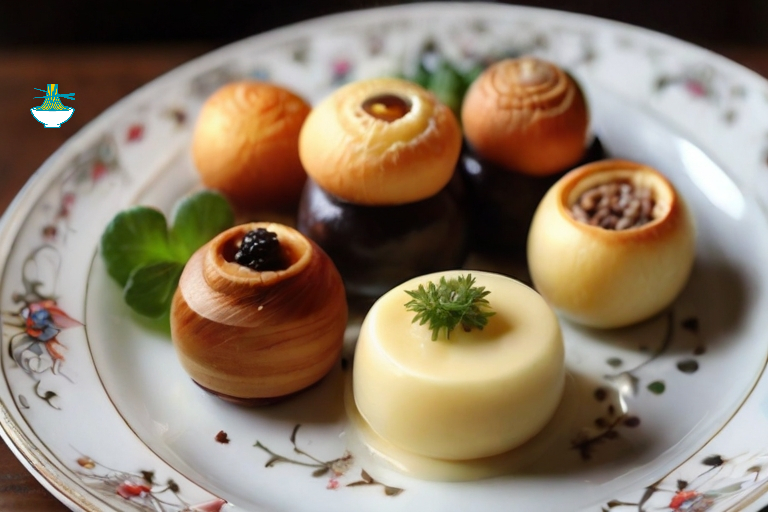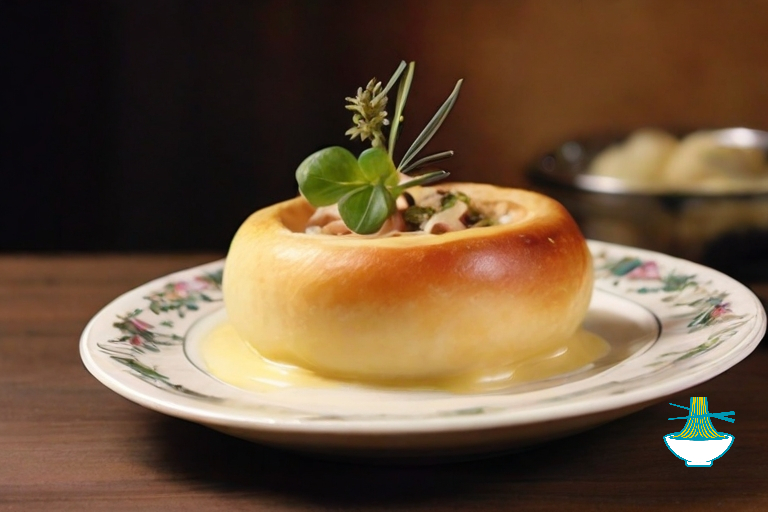Knödel (pronounced "knoedel") is a traditional Austrian dish made of boiled or fried dumplings, known for its rich taste and versatility. These dumplings, crafted from ingredients like bread, flour, milk, eggs, and sometimes potatoes, are a staple in Austrian and Central European cuisine. Knödel is not only delicious but also provides essential nutrients such as carbohydrates for energy and proteins from eggs and milk. Additionally, the dish contains vitamins like B-complex from bread and eggs, which support energy metabolism. However, excessive consumption, especially of fried variations, may contribute to weight gain or increased cholesterol levels. Overall, Knödel is a satisfying, nutrient-packed dish, best enjoyed in moderation.

Here is a step-by-step method for making Knödel:
Ingredients:
1- 6 slices of bread, crusts removed
2- 1 cup of flour
3- 1/2 cup of milk
4- 2 eggs
5- 1/4 cup of butter
6- Salt and pepper to taste
Instructions:
1- Begin by soaking the bread in the milk until it is soft.
2- Next, add the flour, eggs, and seasoning, and mix well to combine.
3- Let the mixture sit for a few minutes to allow the flour to absorb the moisture from the other ingredients.
4- Form the mixture into small balls, about the size of a golf ball.
5- Bring a pot of salted water to a boil, then reduce the heat to a simmer.
6- Add the Knödel to the water, making sure they do not stick together.
7- Cook for 20-25 minutes, or until the Knödel float to the surface of the water.
8- Remove the Knödel from the water using a slotted spoon and drain them on paper towels.
9- Optionally, you can fry the Knödel in butter until they are crispy on the outside.
Notes:
- High in calories, especially fried versions.
- May contribute to cholesterol levels if consumed excessively.
- You can add different seasonings to the Knödel, such as nutmeg, parsley, or chives, to give them different flavors.
- Knödel can be served with a variety of dishes, such as beef stew, pork roast, or sauerbraten.
- You can also use different types of bread, such as rye or sourdough, to give the Knödel a different texture and flavor.
FAQs
1.What are the best types of bread to use for Knödel?
- White bread or stale bread is commonly used, but rye or whole-grain bread adds richer flavor and nutritional value.
2.Can Knödel be frozen?
- Yes, cooked Knödel can be frozen in airtight bags. To reheat, steam or simmer them for the best texture.
3.What is a healthier substitute for butter in Knödel?
- Olive oil or coconut oil can replace butter for a healthier version.
4.What is the difference between boiled and fried Knödel?
- Boiled Knödel are soft and light, ideal for soaking up sauces. Fried Knödel are crispy on the outside and offer a richer flavor.
5.What dishes pair well with Knödel?
- Savory: Sauerbraten, goulash, or pork roast.
- Sweet: Vanilla sauce, cinnamon, and sugar with fruit-filled dumplings.
6.How can Knödel be prepared for a vegetarian diet?
- Knödel can be easily adapted for a vegetarian audience by making the following substitutions:
- Replace milk with plant-based options like almond or oat milk.
- Use vegan egg substitutes, such as flaxseed meal or aquafaba.
- Swap butter with olive oil, vegan margarine, or coconut oil.
Nutrition Facts:
One serving (3 Knödel) of this recipe contains approximately:
- Calories: 408
- Fat: 18g
- Carbohydrates: 50g
- Protein: 13g
- Sodium: 460mg
Here's the nutritional information for each of the items :
6 slices of bread, crusts removed:
- Calories: Approximately 300-360 calories (varies based on bread type)
- Carbs: Approximately 54-72 grams (varies based on bread type)
- Protein: Approximately 12-18 grams (varies based on bread type)
- Fat: Approximately 3-9 grams (varies based on bread type)
- Sodium: Approximately 300-600 milligrams (varies based on bread type)
Benefits :
- Carbohydrates: Bread is a good source of carbohydrates, which provide energy.
- Fiber: Whole grain bread, in particular, contains dietary fiber that aids in digestion.
- B Vitamins: Bread contains B vitamins such as thiamine, niacin, and folate, which are important for energy metabolism and brain health.
- Iron: Bread often contains iron, which is essential for the production of red blood cells.
1 cup of flour (all-purpose flour):
- Calories: Approximately 455 calories
- Carbs: Approximately 95 grams
- Protein: Approximately 13 grams
- Fat: Approximately 1.2 grams
- Sodium: Approximately 2 milligrams
Benefits :
- Carbohydrates: Flour provides a significant amount of carbohydrates, essential for energy.
- Protein: Flour, especially whole wheat flour, contains protein which is necessary for muscle repair and growth.
- Fiber: Whole wheat flour is high in dietary fiber, which promotes healthy digestion.
- Vitamins and Minerals: Flour can provide essential vitamins and minerals, including B vitamins, iron, and magnesium.
1/2 cup of milk (whole milk):
- Calories: Approximately 74 calories
- Carbs: Approximately 6 grams
- Protein: Approximately 3.3 grams
- Fat: Approximately 4.1 grams
- Sodium: Approximately 41 milligrams
Benefits :
- Calcium: Milk is an excellent source of calcium, which is vital for strong bones and teeth.
- Protein: Milk contains high-quality protein, essential for muscle repair and growth.
- Vitamins: Milk provides essential vitamins such as vitamin D, vitamin B12, and riboflavin.
- Hydration: Milk helps maintain hydration due to its high water content.
2 eggs:
- Calories: Approximately 140-150 calories (varies based on egg size)
- Carbs: Approximately 1-2 grams (varies based on egg size)
- Protein: Approximately 12-14 grams (varies based on egg size)
- Fat: Approximately 9-10 grams (varies based on egg size)
- Sodium: Approximately 124-142 milligrams (varies based on egg size)
Benefits :
- High-Quality Protein: Eggs are a complete protein source, containing all essential amino acids.
- Choline: Eggs are rich in choline, important for brain health and liver function.
- Vitamins and Minerals: Eggs provide a range of vitamins (A, D, E, B12) and minerals (iron, selenium, phosphorus).
- Antioxidants: Eggs contain antioxidants like lutein and zeaxanthin, which are beneficial for eye health.

1/4 cup of butter:
- Calories: Approximately 407 calories
- Carbs: Approximately 0.4 grams
- Protein: Approximately 0.5 grams
- Fat: Approximately 45 grams
- Sodium: Approximately 357 milligrams
Benefits :
- Fat-Soluble Vitamins: Butter contains vitamins A, D, E, and K, which are fat-soluble and essential for various bodily functions.
- Healthy Fats: Butter provides a source of healthy fats that can be beneficial in moderation.
- Conjugated Linoleic Acid (CLA): Butter from grass-fed cows contains CLA, which may have health benefits including anti-cancer properties.
- Butyrate: Butter contains butyrate, a short-chain fatty acid that has been linked to reduced inflammation and improved gut health.
Salt and pepper to taste:
- Negligible calories, carbs, protein, and fat.
- Sodium: The amount of sodium added depends on how much salt is used.
Benefits :
- Salt: In moderation, salt is essential for maintaining proper electrolyte balance, nerve function, and muscle contraction.
- Pepper: Black pepper contains piperine, which has anti-inflammatory and antioxidant properties and may improve nutrient absorption.
Please note that the nutrition information may vary depending on the type of bread and other ingredients used.


Comments